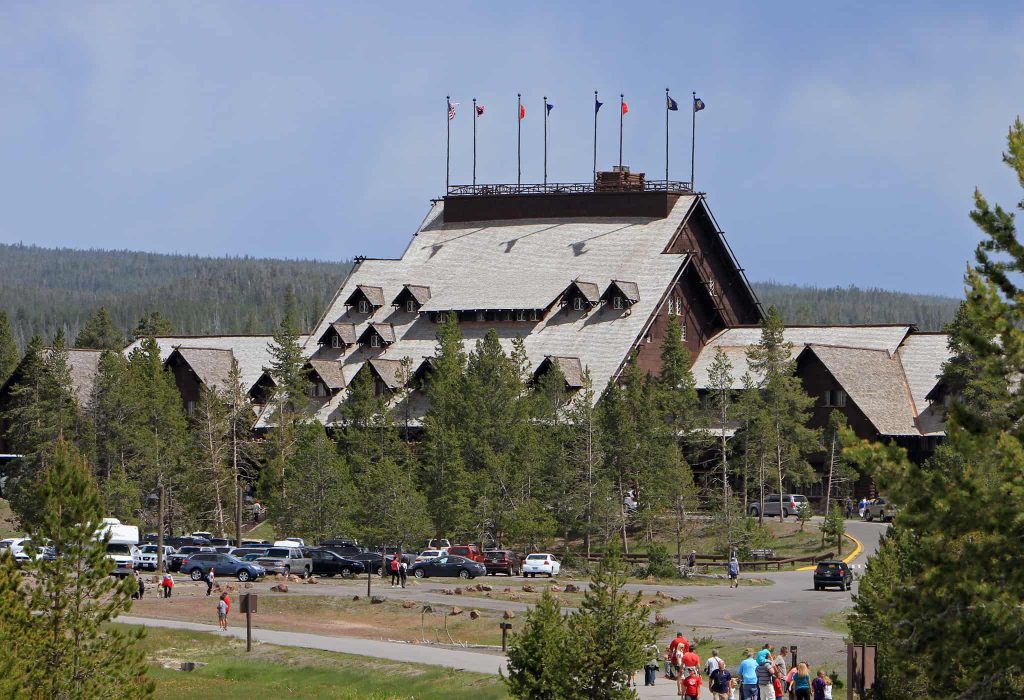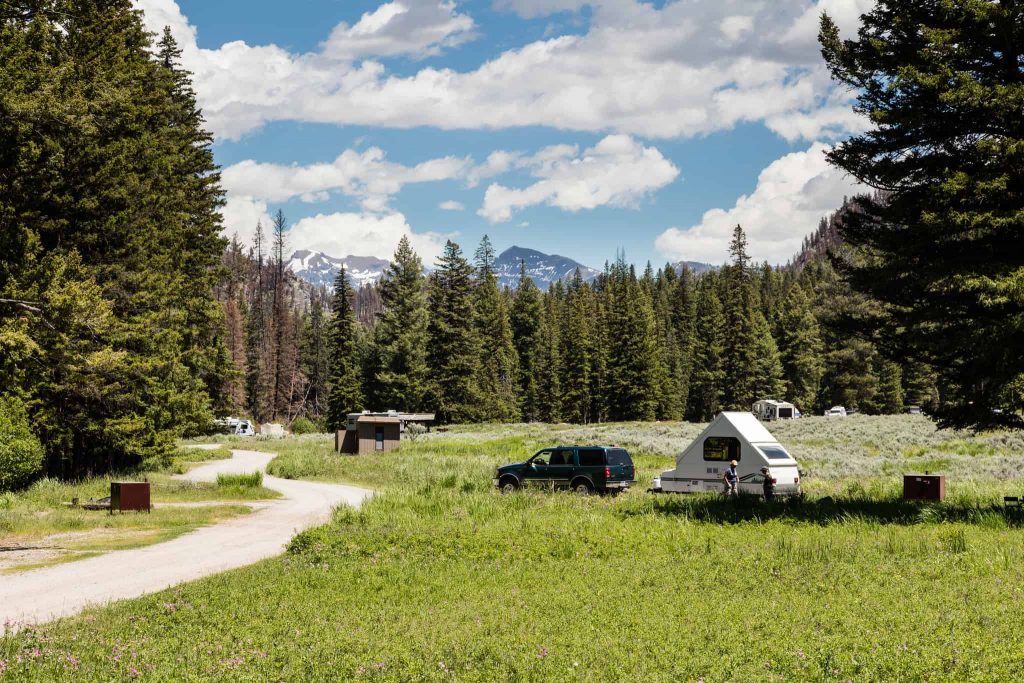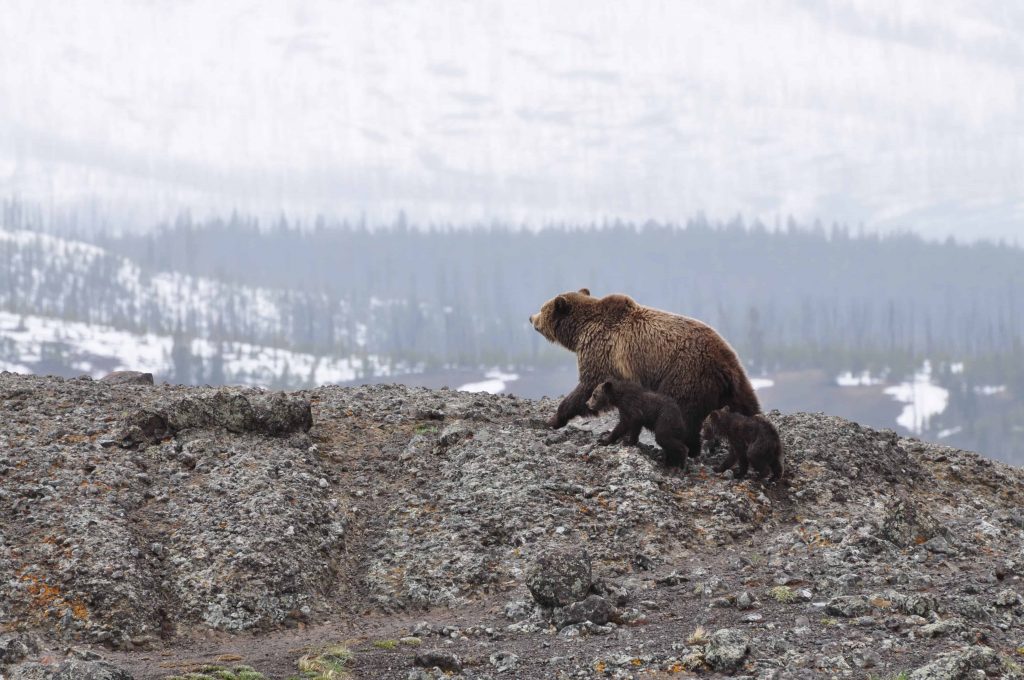Yellowstone became the country’s first national park in 1872. Yellowstone is known for its hydrothermal features, lakes and rivers, lodgepole pine forests, alpine meadows, and the largest concentration of wildlife in the lower 48 states.
The immense park consists of 3,437.5 square miles. Ninety-six percent of it is in Wyoming, with some land in Montana and Idaho. Yellowstone encompasses state lands, two national parks, parts of five national forests, three national wildlife refuges, Bureau of Land Management property, and tribal and private lands. Most of Yellowstone is more than 7,500 feet above sea level. Snow covers the terrain much of the year.
Where To Stay In Yellowstone
Well before heading for the park, visitors need to decide where they are going to sleep during their stay. Lodging facilities must be reserved in advance.
Yellowstone National Park Lodges operates nine hotels, with more than 2,000 rooms. The establishments are open from late spring through fall, but only Old Faithful Snow Lodge and Mammoth Hot Springs Hotel are available in the winter. Cabins offer a rustic alternative.

Yellowstone has 12 campgrounds for tents and RVs, five of which take reservations through Yellowstone National Park Lodges. The other campgrounds operate on a first-come, first-served basis.
There are more than 300 designated backcountry sites. Permits are required for overnight stays in the wilderness. They are to be purchased no more than 48 hours ahead of time, at a visitor center or ranger station. However, it is possible to reserve some of the backcountry sites in advance.

Before traveling to the park, it is important to find out about weather conditions, closed roads, and whether certain services and activities are available.
Things to Do In Yellowstone
The best way to take part in the myriad activities available in Yellowstone is to contact park-approved companies that provide services and tours.
Private firms arrange, lead and equip trips for backpacking, bicycling, boating, day hiking, fishing, painting and photography tours, skiing and snowshoeing, snowmobile and snowcoach tours, and horseback riding.
To learn about the park, many visitors attend ranger programs. Talks take place at campgrounds and visitor centers; and guided tours lead to Mud Volcano, Yellowstone Lake, Mammoth Hot Springs and Geyser Hill. Other programs include Junior Ranger activities for children, art and photography sessions, and a nature writing workshop.

Yellowstone has more than 10,000 hydrothermal sites, including geysers, hot springs, mudpots and fumaroles. More than half of the world’s active geysers are found here. A Yellowstone tradition is watching the Old Faithful geyser erupt every 44 to 125 minutes.
There are more than 900 miles of hiking trails, most of which pass through wilderness areas. Visitors must be aware of potential hazards such as snow, fast-flowing rivers, hydrothermal areas, avalanches and unpredictable animals.

This is a premier destination for wildlife viewing. Yellowstone is home to one of the largest elk herds in North America, and the country’s biggest free-roaming herd of wild bison. There are also wolves, grizzly bears, moose, black bears, mountain lions, bighorn sheep, mountain goats, mule deer, white-tailed deer, pronghorn, lynx and wolverines. The park has 300 bird species and 16 kinds of fish.

Bicycling is allowed on public roads and other designated routes, as well as in parking areas. Yellowstone permits bicycling on established public roads and in parking areas. There are no paths along the roads. Bikers are not allowed on backcountry trails or the boardwalks that provide access to geothermal sites. Visitors may rent bicycles at the Old Faithful lodge.
Horseback-riding outfitters offer day trips and multi-day backcountry adventures. Equestrians may bring their own stock. Overnight trips are permitted only from July 1 until winter, due to wet trail conditions.
Anglers head for the lakes and streams. Yellowstone hosts 11 native fish, like mountain whitefish, Arctic grayling and the prized cutthroat trout. There are four types of trout (rainbow, brown, brook and lake).

Canoes, kayaks, paddleboards and other boats hit the water between Memorial Day and early November. Motorized craft are allowed only on Lewis and Yellowstone lakes, and all boats on banned on four lakes. The park’s streams are closed to boating, except for one section of the Lewis River. The maximum craft length is 40 feet.
Yellowstone does not permit jet skis, person watercraft, airboats or submersibles. Visitors may not tow water skiers, and activities such as wakeboarding and parasailing are prohibited.
Yellowstone affords few opportunities to swim. Most of the waters are either too cold or too hot. Soaking in hot springs is not allowed. Places to get wet are a portion of the Boiling River, near Mammoth Hot Springs; and the Firehole Swim Area, on the river of the same name.
Winter is a special time to visit the park due to smaller crowds and the chance to experience solitude. There are miles of trails, some with pre-set track, for skiers and snowshoers. All unplowed roads and trails are open to cross-country skiing and snowshoeing. In early November, when most park roads close for the winter, the preferred modes of transportation become snowmobiles and snowcoach. Six authorized companies lead tours. Backcountry campers appreciate the pristine beauty of Yellowstone in winter. They get into the wilderness with skis or snowshoes.

Fifty-two picnic sites are scattered through the park. Each one has tables, and most have vault toilets, but just one site provides drinking water. Other dining options are Yellowstone’s many eateries. They include restaurants, cafeterias, snack shops, ice cream counters, coffee shops and bars. All the facilities are near one of the eight visitor centers.
Getting There and Park Transportation
The nearest airports for commercial planes are in Cody and Jackson, Wyoming; Bozeman and Billings, Montana; and Idaho Falls, Idaho. Travelers can fly from Salt Lake City, Utah, to the West Yellowstone Airport from early May to mid-October.
Buses run all year from Bozeman to West Yellowstone on U.S. Highway 191. Bus service directly from Idaho to West Yellowstone is limited to the summer. There is no train service. The nearest Amtrak depots are in southeast Idaho, Salt Lake City and northern Montana.
Most people use their own vehicles to explore this vast park, where popular attractions are many miles apart. Yellowstone does not provide public transportation, but numerous companies offer shuttles and tours.

